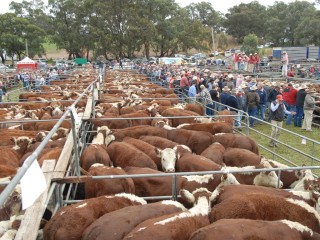 Supply issues, rather than demand-side pull-through, is driving a solid lift in cattle prices over the past week, with MLA’s Eastern Young Cattle Indicator jumping 13c/kg in the seven days to Monday to reach 387.25¢, before easing 1c yesterday.
Supply issues, rather than demand-side pull-through, is driving a solid lift in cattle prices over the past week, with MLA’s Eastern Young Cattle Indicator jumping 13c/kg in the seven days to Monday to reach 387.25¢, before easing 1c yesterday.
Monday’s figure was the highest seen since early May.
Some export processors delivered on expectations discussed in Beef Central on Monday, lifting over-the-hooks prices on many descriptions another 5c/kg yesterday, further adding to recent market momentum.
Cattle yardings in southern Australia have been significantly reduced this year on the back of much better seasonal conditions across Eastern states, which have encouraged producers to hold onto stock and attempt some herd rebuilding.
Another factor in slow supply in the south has been the big money paid for weaner cattle at the start of the year. With many weaners changing hands in January/February for 230-240c/kg, the only way out of those cattle today is to add as much weight as possible before sale.
Rain last week across large expanses of NSW, with better than expected falls across areas like Gunnedah, Dubbo, Forbes, Wagga and Parkes was extremely timely, given that large expanses of cattle country in NSW that were drying off rapidly. Pasture conditions across central and southern regions of NSW will now get a much-needed kick, giving producers increased flexibility in coming months when looking at turnoff options.
The effect of rain was reflected at Monday’s Tamworth sale, where young cattle numbers were well back on the week previous.
Meat & Livestock Australian chief economist Tim McRae agreed that cattle supply factors, coupled with the NSW rain effect over the last ten days for forecast again this week, had combined to offset the drier conditions in Queensland a little in recent market indicators.
Good gains have been made in all NLRS categories since this time last week with trade steer, medium steer, heavy steer and feeder steer rates up 5c, 4c, 3c and 8c respectively to yesterday.
The softer, and less volatile A$ value, which has settled in the US103’s over the past seven days, has also encouraged export processors to push forward on offer prices over the past fortnight, with some direct consignment rates for slaughter cattle now 15c/kg higher than early August.
 Early signals of a return to La Nina weather patterns this summer, if proven correct would be a huge bonus to the industry, Mr McRae said.
Early signals of a return to La Nina weather patterns this summer, if proven correct would be a huge bonus to the industry, Mr McRae said.
“Another good season across northern Australia would be critically important for livestock producers caught up in the live export market disruptions,” he said.
“A poor monsoon season would really cripple many northern cattle men and women, given stock on hand. But a good body of feed would give them room to hold and put weight onto cattle, giving more options,” he said.
“Looking seasonally at other parts of the continent, South Australia and Victoria look pretty good, with many southern Victorian and Tasmanian producers still dealing with very wet paddocks. On top of a wet winter, some warmer weather now and some good falls for crops would help, and the rain in central NSW was extremely well-timed to boost prospects for a spring break.”
Asked whether there was still upside on the current EYCI numbers, Mr McRae said that could happen, given further good falls, particularly in southern Queensland.
“But at 386c as it was yesterday, we would say in any other year that that was about as high as it could go. It is close to uncharted territory for the EYCI for this time of year. It peaked in August/September 2005 at close to 400c, but that was the only other time the young cattle market has been this strong at this time of year,” he said.
“The current figure is particularly strong, given the A$ is now well above parity with the US currency.”
Southern livestock agents told Beef Central yesterday that tight supplies were driving local market movements.
Gerard Ryan from Brian Unthank Rodwell at Albury said cattle numbers in the Southern Riverina and Northern Victoria were 15-25pc lower than usual levels, a result of dry seasons prior to the seasonal improvement that occurred 18 months ago.
Producers were focusing on rebuilding herds and there were now more people wanting to buy stock than there were cattle available, he said.
Further south at Leongatha in eastern Victoria, Stevens Egan Johnston (SEJ) auctioneer Stuart Jenkin said prime cattle supplies were well back on normal levels because wet conditions had forced stock to be sold-off and cattle had not done as well as normal.
Processors were battling to secure enough cattle to service their needs from prime markets, while tight supplies had also driven a recent rise in store markets, Mr Jenkin said.
“People are looking to restock, and those numbers of store cattle are light as well, so the combination is fuelling a bit of fire in the store sale. Stores have risen $40-$50 in the last two weeks and have probably jumped $100 over the last fortnight to three weeks.”
He said the price rises were supply driven and had been across the board for all categories.
Mr Ryan and Mr Jenkin both anticipated there was unlikely to be a significant increase in southern yardings until early November.
